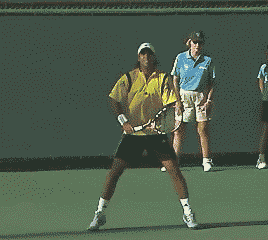TennisOne Lessons Energy Management, Part 1 - Restraint of Impulse Doug King As we witness the final rounds of the U.S. Open, we are collectively stunned at the incredible power unleashed on the ball shot after shot. From Roddick serves, to Agassi returns, from Justine backhands to Maria forehands, you almost expect the ball to explode from the force of contact. Every year the players seem to be hitting the ball harder and harder. One can only wonder where the power comes from and where it will lead.
But looked at from another angle it is not the sheer power that is so amazing but the ability to hit with that kind of power and keep the ball in the court - and to do it repeatedly. You see, anyone can hit the ball hard. In fact, I have to enforce disciplinary sanctions on six year old kids who compulsively hit balls over the fence. The hard part is to swing with that kind of force and getting the ball to connect to the sweet spot and then to be able to make the ball go over the net and land in the court. Power is actually built into the tennis game. The ball is bouncy and the racquet is springy. The arm naturally whips the racquet around to smack the ball with incredible force. What is not naturally a part of tennis is the ability to hit the ball hard over the net and then have it come down and land inside the baseline. What also is not naturally part of tennis is to have the arm swing the racquet around and have the ball hit the center of the racquet consistently. These things are not “naturally” designed into the game. They are obstacles. They must be overcome through learned patterns of behavior. It is through the mastery of technique that we overcome these obstacles. These are the challenges of the game and every game has certain challenges built into them. Two Deadly Impulses - Swing and Hit Let's get a couple of things clear: first, the “natural” hit of the ball is powerful. Watch any kid who picks up a racquet for the first time and bounces a ball repeatedly on the court and you will see they naturally hit too hard. There is a natural “impulse” of the ball to fly off of the racquet when it is struck with significant force. Second, the “natural” swing is circular. The arm naturally swings in circles around the shoulder and the racquet is naturally designed to be an extension of the arm. Energy has a natural “impulse” to flow out to the tip of the racquet and arc the racquet with centrifugal force. This is a very flawed way to get two moving objects (the ball and racquet in this case) to precisely line up in time and space. In addition this kind of a swing is prone to deliver too much “hit” or collision for anyone to reasonably control. These two obstacles (restraining the natural explosiveness of the hit of the ball off the racquet and compensating for the inaccuracy of the natural arcing of the swinging of the arm) represent the two basic challenges addressed by tennis technique. We call these two flaws “over hitting” and “over swinging”, and yes there is overlap between the two. |

